Crentsil Kofi Agyekum, Huang Haifeng, Amma Agyeiwaa
Management and Economics Department, Beijing University of Tech, Beijing, China
Correspondence to: Crentsil Kofi Agyekum, Management and Economics Department, Beijing University of Tech, Beijing, China.
| Email: |  |
Copyright © 2015 Scientific & Academic Publishing. All Rights Reserved.
Abstract
This research sought to delve into the consumer perception of quality of a product. This study is generally embarked to determine the age income and educational level of consumers, if it has or no effect on their perception on product quality specifically and their decision to buy the product. It also to find out what influence the consumer in determining the quality of the product as well as to understand if there is a positive relative relationship between price and the product quality, a case study of Kumasi in Ghana West Africa. It was discovered that, consumers have different ideas or perception on the product quality based on their ages, income levels, and, educational background and this goes a long way to influence them on the criteria used in determining the quality of product when making a purchase.
Keywords:
Consumer, Perception, Quality, Variables, Consumer behaviour
Cite this paper: Crentsil Kofi Agyekum, Huang Haifeng, Amma Agyeiwaa, Consumer Perception of Product Quality, Microeconomics and Macroeconomics, Vol. 3 No. 2, 2015, pp. 25-29. doi: 10.5923/j.m2economics.20150302.01.
1. Introduction
Consumers purchase a product or service on the basis of satisfying their recognized needs (palmer, 2001). The choice of this product to satisfy particular needs depends on the perception of the consumer about the product quality capable of the satisfying that needs. According to Perrault et al (1997) Many business Managers get wrapped up in the technical details involved in producing a product, but most customers or consumers think about product in terms of the quality and the total satisfaction it provides.In this direction, the only way for a firms product to survive in the Market and to design a product with the variables that consumers use to determine product quality. Different consumers perceive quality in different turns. Some have the perception that, product with high price is of high quality to one consumer may be an inferior to another person.In Ghana for instance people perceive product being sold in super markets and retail stores to be of a high quality. In view of this, it is difficult to define what quality product is, because of different perceptions hold by different consumers.Although some of the attributes of quality must be measured objectively, quality must be measured in terms of buyers perception (Kotler e tal 1999) Therefore, it is obvious that managers cannot boast of having the quality product on the market. Since quality based on buyers perception
2. Consumer Perception
Consumers use different variables to determine the quality of a product. These quality lies in the eyes of the consumers in question. What may be seemed to be of high quality to one consumer may be inferior to another. Even though many consumers uses price as an indicator of product quality (Kotler 2001), there are doubts in consumers mind whether there is a relationship between price, value and product quality and further price itself is a strong indicator of product quality in the absence of any information.However, some consumers also determine rice quality based on the country of origin whilst others based quality on producer. It is clear that, consumers evaluate directly attribute by physical cues such as tasty, smell and size. Others use variable such as place of origin, type of distribution channel, price, packaging the manufacturer and among others. Perception plays an important role in life of the consumer. Our environment including business environment is littered with numerous stimuli trying to attract our attention. The quality of our perception depends on the way we process and interpret the stimuli or the information reaching our senses. Perception is the process, by which an individual select, organizes and interpret information inputs to create meaningful picture of the world. When we interpret a situation or events we are then in position to respond. (Kotler, 1997).Perception, according to Gregory et al (1995), is a set of process by which an individual becomes aware of and interpret information about the environment. If everyone perceived everything the way, things would be a lot simpler, of course, the reverse is true. Moreover, people often assume that, reality is objective that, we all perceive the same things in the same way.According to Markin (1995), perception is concerned with the way in which we select and recognize sensory data presented by our environment. In other words perception may be defined as a complex process by which people select, organized and interpret sensory stimuli into meaningful picture of the world. Markin Continues that, a number of stimuli constantly reaching consumers sensory organs from the environment they select certain stimuli to which they attend, they organized these stimuli so that they become understandable, but their interpretation of sensory stimuli involves more than just receiving and processing information by attitudes and beliefs and their past learning as is by the character of the stimuli themselves.And understanding of perception process is important to the producer or the manufacturer. This is because Consumers decision to purchase a product will be influenced to a large extent by the attribute which the successful marketer is able to give or lend to the product through advertising, packing, Manufacturing, Country of origin and other promotional techniques which in a way determined product quality.Psychologists have succeeded in identifying a number of factors that are important in determining the direction of attention.They can be broadly classified under external and internal factors External factors relates to physical characteristics of stimuli, while internal factors include our motives and expectations which also affect the way consumers determine product Quality.Courtland L, Bovver and John J. Thrill (1992, P 153) have the view about perception; before consumers can buy a product, they must be aware that it exist. This is a process that starts with being exposed to the stimuli that represent a particular product, attending to these stimuli and interpreting them to form an overall perception of the object. The Steps involve exposure, attention and interpretation.
3. Consumer Behavior
Consumers respond differently to the same external forces that are they perceive those forces differently. This perceptions is said to be the way they gather and record information (Gilbert A. Churchill and Douglass F. Halley, 1997).It is believed that, it is not to be satisfied and delighted as they must perceived that the product is excellent (Larforce et al, 1995).Some have come out with the following trend affecting Consumer behaviour.Shoppers increasingly economizing or down scaling to less expensive brands, Searching for deals, waiting longer to but, balancing quality and price Consciousness.Consumers moving from conspicuous consumption to rational Consumptions and cautions use of finance.Consumer utter behaviour and diets to reflect great concern for health and physical fitness. The aging of the population, long life expectation and lower birth rates. Changes in family and work force Composition making men and woman increasingly similar in choices of product and services.According to the journal of marketing Research, Self-perception theory provides a theoretical frame work within which behavioural influence strategies can be investigated.In essence, self- perception theory specifically the process and conditions under which a person past behaviour is used as data in making influence upon the circumstances in which behaviour is enacted. Specifically the central preposition of buyers perception theory stated individual comes to know their own attitude, emotions and the internal states practically by informing them from observation of their own behaviour and the situations in which the behaviour occurs, when Consumers do infer a positive relationship likely to compare the two stores dealing with 2 different products, the key point is the judgment quality based on the brand name or the channel of distribution are necessarily comparative and perceived differences in product, lend to relative and perceived differences in product quality varies significantly (journal of Marketing Research 1976).
3.1. Selective Perception
Since the average consumer operate in an environment, the Human brain attempt to organize and interpret information with a process called selective perception a filtering of exposure. Selective exposure occurs when the people pay attention to the message that is consistent. With their attitude and beliefs and ignore the messages that are inconsistent. Selective comprehensions involve interpreting information, so that it is consistent with your attitude and beliefs.A marketer failure to understand this can have disastrous results. Selective retention on the other hand means that consumers do not remember all the information they see, read, and hear even minute s after exposure to it this effect s internal purchase decision (Brekowitz et al 1997).
3.2. Quality of a Product
According to Stephen Page (1995) product is anything offering to consumer which either solve problem or provide benefit including any "add-ons" e.g. guarantees. In many cases, product will be the most important element in the marketing mix; it lies at the care of successful marketing. Page stated that the future of a product must match closely as possible the benefit that consumers are seeking. Getting the quality of product requires an understanding of what consumers expect. This means that not only that of quality must do what is claimed for it and stand up well in comparison with rivals, but it also comes in that the consumers consider being the right colour, weight and packaging size. Basic quality features product may be extended by the variety of the so called so "ad dozes (added features). in the case of durables these may take the form of aftermarket support example .extended guarantees repair and maintain services. Product are the focal point by which companies seek to satisfy consumers need. The term product can mean many things to many people. Most people, when they consider marketing of a product tends to think of fast moving consumer good (FMCGS) such as powder or chocolate bars.In fact, the term product can mean many things; product therefore is any tangible or intangible item that satisfies a need.
3.3. Background of Respondents on Quality Survey
The tables and charts below represent the background of respondents that gender, age, education level, employment status and income levels.Age distribution of respondents.Table 1. A table showing age distribution of respondents
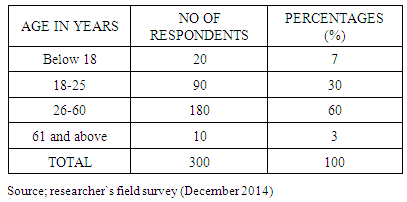 |
| |
|
Based on the table 1, it can be concluded that majority of the respondents were those between the ages of 18-60 years. The youth in general were the Majority of the respondents.From the table 1, out of the total number of 300 respondents, 180 of them representing 60% were those between the ages of 26-60 years, 90 respondents representing 30% were between the ages of 18-25 years, 20 respondents representing 7% were below 18 years while respondent which represent 30% was above 60 years. | Figure 1. Diagram showing the Gender distribution |
Based on the table 1, it can be concluded that majority of the respondents were those between the ages of 18-60 years. Table 2. Gender distribution of respondents
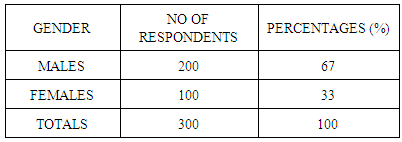 |
| |
|
The study sought to collect information on the educational level of the respondents.Table 3. A table showing the educational background of respondents
 |
| |
|
The table 3 shows the educational level of the respondents. Out of the 300 respondents, 130 of them representing 43being University graduates, 24% of them were Vocational school, level graduates, 40respondents representing 13% being Polytechnic graduates also were high school leavers 40 respondents 13% whilst 20 respondents representing 7% were others with different qualifications.The study also sought among others to collect data on the employment and income level of the respondents. This analysis will help the income level of respondent who perceive quality base on price. Among the (300) respondents, 30 respondents representing 10% were unemployed and that earn no income at the end of the month, whiles 90% were income earners, that has been employed.The table 4 shows the income distribution of the respondents.Table 4. Showing an income level of respondents
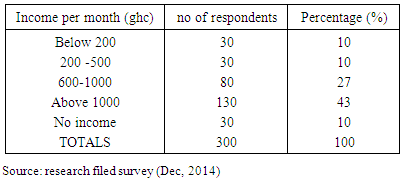 |
| |
|
The table 4 depicts the income level of the respondents 130 respondents representing 43% earn an income above GH¢ 1000 per month, 80 respondents representing 27% earn between GH¢600 – 1000 per month, 10% of the respondents fall within those who earns below GH¢200 per month and 30 respondents representing 10% of who earns no income.The tables 5 represent variable that consumers consider in determining product quality, which comprise; price, brand name, country of origin place of purchase and manufacturer.Table 5. Table Showing Respondents Variables used
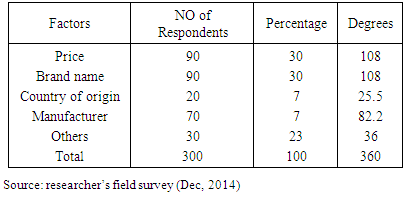 |
| |
|
From the table 5, 90 respondent representing 30% consider price as a strong indicator of quality, also 90 respondents representing 30% define quality based on the brand name, 23% of the respondents use the name of the manufacturer as a strong indicator of quality and 10% and 7% base their definition of quality on country of origin and others respectively.The table can further be illustrated as follows: showing variables used by respondents to determine product quality. Clearly the table confirms the results above, where 90 respondents opted for the country of origin 70 for manufacturer, 90 for brand name and 30 representing others.Table 6. Shows respondents preferred countries they like their product
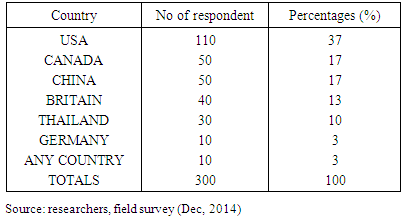 |
| |
|
The table 6 shows that, 37% of the respondents like product from USA, 17 Canada, 17% China, whilst 13% preferred from Britain, Thailand 10%, 36 respondents representing Germany and any country respectively.Table 7. Showing consumers place of purchased
 |
| |
|
From the table 7, out of the three hundred (300) respondents, 200 of them purchase from open market shops. Out of the 200, 50% represent males and females 17%. Out of the 300, 100 purchases from supermarket, from supermarket 16.5% represent males, and 16.5% represent females. None of the respondents purchase from others apart from the two areas above, where open market shops are the major place purchase of the respondents. 17 people of the three hundred purchase from open market shops, 33% of the respondent buy from super markets.
4. Conclusions
The findings suggest that clearly the effect of brand name and price representing 30% respectively is stronger than country of origin and manufacturer and mathematically insignificant. The effect of the producers or the manufacturers on the perceived quality of a product has relative impact on it. Findings from various table depicts that consumers,Use price and brand name more than any other element or criteria on determining the quality of a product.The significance of the above findings basically follows their accuracy or the extent to which a particular signal like brand name or price for example, typically is shears by only few products within a competitive line of products and is therefore a very significant criterion. The manufacture’s country of origin can be sheared to a greater extent across competing products that are less specific that is, the more specific a signal all things being equal the more likely that signal will provide information that is the useful an assessment of a particular product quality.According to Kotler, (1984), branding or brand name is a trade mark which though a carefully management, skilful promotion and wide use, come in the minds of consumers to embrace a particular set of values and attributes both tangible and intangible. In future this research may intend to find out and study the price perception extending to specific service and purchases made by business and institutional buyers.
ACKNOWLEDGEMENTS
I wish to acknowledge the entire stuff of Int. College of Beijing University of Technology. And also to Mr. Wang Xinyu, Mr and Mrs Agyekum and all friends in Beijing university of Technology (Bjut), for their massive support.
References
| [1] | Kotler and Armstrong; Principle of Marketing. |
| [2] | Kotler E’tal; Principles of Marketing; Pp240-242. |
| [3] | Larforce Ingram; Marketing Principles And Projective; Fourth Edition. |
| [4] | Berkowitz e’tal; Marketing; Irwin McGraw Hill Fifth Edition Pp. 159-160. |
| [5] | Cortland L. Bouee and John V. Thill; Marketing; .Pp.736-7. |
| [6] | Gilbert A .Churchill Jr. And J. Paul Peter; Marketing Creation Valve for Customers; Pp.240-242. |
| [7] | Palmer, 2001. |
| [8] | Kotler e tal 1999. |
| [9] | Courtland L, Bovver and John J. Thrill P 153. |
| [10] | Gilbert A. Churchill and Douglass F. Halley. |
| [11] | Gregory e`tal (1995). |
| [12] | Gilbert A. Churchill and Douglass F. Halley, 1997. |
| [13] | Jacoby Szybillo and Busato; Boa and Monroe, Product Quality Signal Schacht. |
| [14] | Journal of Marketing Research; Buyers' perception. |
| [15] | Stephen Page; Introductory Marketing; Pp 73, 76, 77. |
| [16] | William D. Perrault Jr. And E. Jerome McCarthy, EtiaOMarketing;. Pp162-181. |


 Abstract
Abstract Reference
Reference Full-Text PDF
Full-Text PDF Full-text HTML
Full-text HTML





